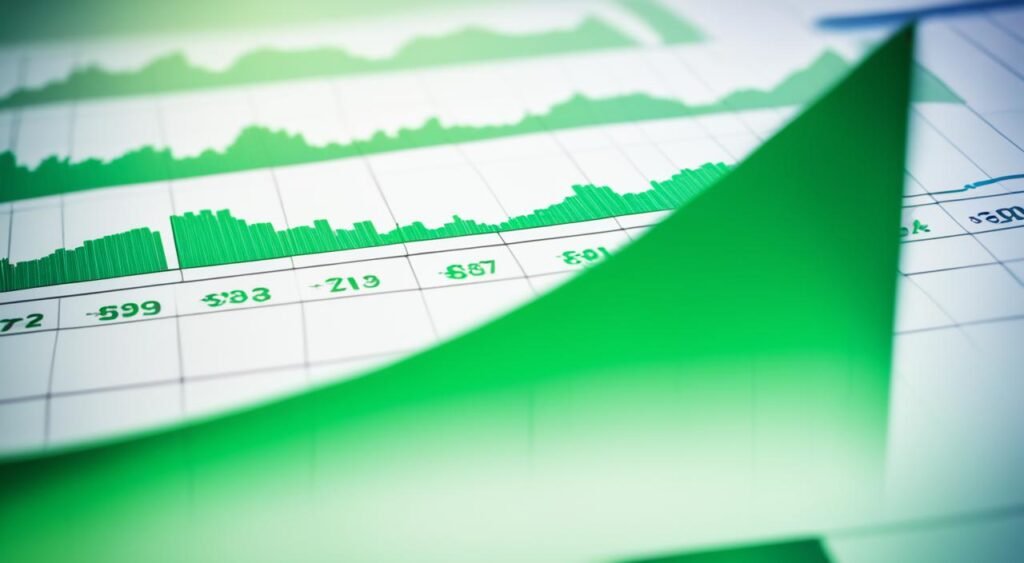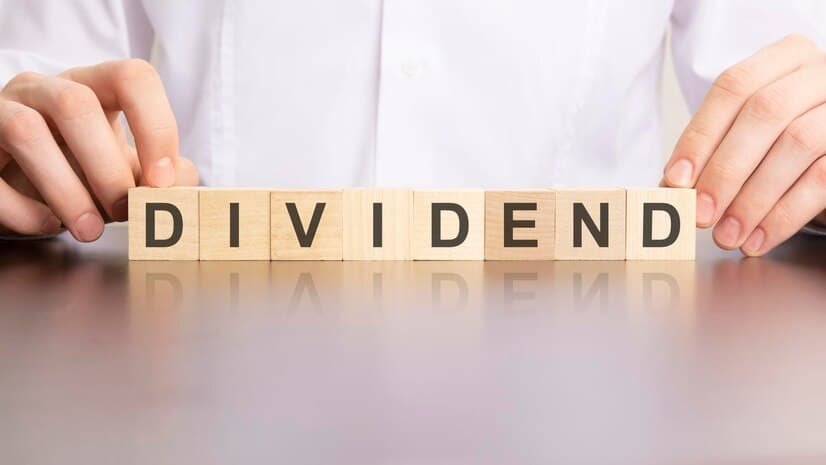Dividends are like rewards given by companies to their shareholders. These rewards can be cash or more shares. This is called a stock dividend. Investors like dividend-paying stocks because they offer a steady income every quarter.
They see companies that pay dividends as stable. This stability helps during bad times in the stock market.
Companies decide if they will give dividends. This decision is made by the company’s leaders. Knowing if a stock might pay dividends can help investors predict their earnings.
People who want a regular income find dividend stocks attractive. They’re also good for those aiming to grow their wealth over time.
Key Takeaways
- Dividends are payments made by publicly traded companies to their shareholders.
- Dividends can be paid in the form of cash or additional shares (stock dividends).
- Dividend-paying stocks are often seen as more financially stable and may provide a buffer during market downturns.
- Dividends are determined by a company’s board of directors and can be an important factor in evaluating a stock’s total return potential.
- Dividend-paying stocks can be attractive to investors seeking a steady stream of income or long-term wealth building.
Understanding Dividends
Dividends are very important in the world of investing. They are the earnings that companies share with their shareholders. This sharing happens through cash payments made by a company to its shareholders. It usually occurs four times a year. The dividend size depends on what the company’s board of directors decides. It is distributed for each share a person owns.
Definition and Key Takeaways
To grasp the concept of dividends, it’s helpful to know what they are and remember certain things about them. A dividend definition is quite simple: it’s the company giving its profits to shareholders. This happens under the direction of the company’s board. When discussing dividends, here are the main points to take away:
- Dividends offer investors an income source. This is outside of the potential earnings from the stock’s price going up.
- The dividend yield shows the dividend per share against the stock’s price. Investors look at this to judge dividend stocks.
- But not all companies share their profits this way. Some, especially in tech or biotech, might want to use their profits for growing the business instead.
So, knowing about dividends and their features is key for smart investing. It helps investors pick the right stocks for their portfolios.
“Dividends are how companies reward their shareholders, offering them a regular payment.”
Understanding the dividend definition and key takeaways, along with what impacts a company’s payment policy, is critical. It enables investors to wisely assess the upsides and downsides of putting their money in dividend stocks.
Dividend-Paying Companies

When we talk about dividend-paying stocks and companies that pay dividends, some things always stand out. For the best dividend stocks, look to larger, established businesses with steady earnings. Industries like basic materials, oil, banking, health care, and utilities usually pay regular dividends.
Some companies must pay out most of their profits to investors. Examples are master limited partnerships (MLPs) and real estate investment trusts (REITs). These businesses often provide a solid income for those who want reliable returns.
However, newer, rapidly growing businesses often don’t pay out dividends. These companies, especially in areas like tech and biotech, prefer to use their profits to grow the company. They focus on expanding and doing more research instead of paying dividends to investors right away.
“Dividends are a crucial component of total shareholder return, and companies that consistently pay and grow their dividends can be attractive long-term investments.”
Knowing what to look for in dividend-paying companies helps investors spot good opportunities. This approach can help build a portfolio that fits their goals and how much risk they’re willing to take.
Important Dividend Dates

Figuring out the dividend process can be hard, but knowing the key dates is important for investors. Dividend payments have a specific order, with key points that shareholders need to know.
Dividend Announcement Date
The dividend announcement date is when a company’s leaders say they’ll pay out a dividend. It kicks off the dividend timeline, letting investors know a payout is coming.
Ex-Dividend Date
The ex-dividend date is the last day to buy a stock and get the upcoming dividend. If you buy the stock on or after this date, the dividend goes to the previous owner.
Dividend Record Date
The dividend record date is the date the company uses to decide who gets the dividend. Only those who own the stock on this date get the dividend.
Dividend Payment Date
The dividend payment date is when the company hands out the dividend. This is when shareholders get the dividend funds.
It’s key for investors to grasp this dividend timeline. Knowing these dates helps investors buy and sell stocks at the right time to boost their dividend earnings.
| Dividend Date | Description |
|---|---|
| Announcement Date | The date when a company’s management declares that a dividend will be paid. |
| Ex-Dividend Date | The deadline for purchasing a stock to qualify for the upcoming dividend payment. |
| Record Date | The cutoff date to determine which shareholders are entitled to receive the dividend. |
| Payment Date | The date when the dividend is actually distributed to eligible shareholders. |
“Understanding the dividend timeline is crucial for investors to ensure they receive the payments they are entitled to.”
How Dividends Affect Stock Prices

Dividends are important for a company’s stock price. When a dividend is declared, the stock price changes on the ex-dividend date. This reflects the company giving a part of its worth to shareholders.
The link between dividends and stock prices is simple. On the ex-dividend date, the stock price drops by the dividend amount. This is because new buyers won’t get that upcoming dividend. But, before that date, the stock price goes up by the dividend’s amount. This shows investors they will get part of the company’s worth through the dividend.
This stock price change matters a lot for investors. Knowing how dividends affect prices helps investors decide what to do with a stock. It’s key to understanding a company’s real value and its future growth and returns.
“Dividends are a key driver of shareholder returns, and understanding their impact on stock prices is essential for making informed investment decisions.”
To sum up, dividends can quickly change a stock’s price. Being aware of a company’s dividend schedule helps investors predict and handle stock price changes. This can improve their investment strategies.
Why Companies Pay Dividend
Companies pay dividends to attract and keep investors. They give a part of their profits to shareholders. This action shows the firm is stable and values its shareholders. For companies that sell stock to the public, paying dividends keeps investors happy. It also appeals to those who want regular income from their investments.
Paying dividends is a strong signal of a company’s financial health. If a company gives out dividends often, it shows it can make a steady profit. This is attractive to investors who prefer their investments to make regular income.
Dividends can also draw in more investors. Those who desire a steady income, like retirees, might prefer these companies. With more diverse investors, the company’s stock might become more popular. This could boost its share price.
Yet, some businesses don’t give out dividends. They might choose to use their profits to grow the company. This could be through new projects, research, or other key plans. The choice between dividends and growth is up to the company’s leaders. They base it on the business’s age, future goals, and what’s best for the investors.
| Reasons Companies Pay Dividends | Benefits of Dividends for Companies |
|---|---|
|
|
The choice between dividends and reinvestment shows where a company stands. It highlights their financial situation, growth strategies, and main focuses. This insight helps investors navigate their investment choices wisely.
“Dividends are a way for companies to share their success with their shareholders and demonstrate a commitment to rewarding investor loyalty.”
Fund Dividends

There are more options for people wanting to invest in dividends than just picking single stocks. They can go for dividend mutual funds and dividend exchange-traded funds (ETFs). These choices spread out the risks and rewards of dividend investing.
These special funds gather a variety of stocks that pay dividends. They then share the money they make from dividends, interest, and capital gains with the investors. This makes it easier for people to earn from dividends without the hassle of choosing stocks on their own.
People interested in dividend funds should look into certain aspects. These include the dividend yield, the total returns, and the tax impacts. For example, dividends that meet specific holding rules might get taxed at lower rates.
| Fund Type | Dividend Yield | Potential Tax Benefits |
|---|---|---|
| Dividend Mutual Funds | Varies, typically higher than S&P 500 | Qualified dividends taxed at lower rates |
| Dividend ETFs | Varies, often higher than broader market | Qualified dividends taxed at lower rates |
Choosing dividend funds can help investors. They get a mix of top dividend-paying stocks while maybe enjoying tax perks on those qualified dividends.
“Dividends are a key part of long-term investment gains. Focusing on funds built around dividends can really amp up those benefits.”
Also Read:
Dividends are like rewards given by companies to their shareholders. These rewards can be cash or more shares. This is called a stock dividend. Investors like dividend-paying stocks because they offer a steady income every quarter.
They see companies that pay dividends as stable. This stability helps during bad times in the stock market.
Companies decide if they will give dividends. This decision is made by the company’s leaders. Knowing if a stock might pay dividends can help investors predict their earnings.
People who want a regular income find dividend stocks attractive. They’re also good for those aiming to grow their wealth over time.
Key Takeaways
- Dividends are payments made by publicly traded companies to their shareholders.
- Dividends can be paid in the form of cash or additional shares (stock dividends).
- Dividend-paying stocks are often seen as more financially stable and may provide a buffer during market downturns.
- Dividends are determined by a company’s board of directors and can be an important factor in evaluating a stock’s total return potential.
- Dividend-paying stocks can be attractive to investors seeking a steady stream of income or long-term wealth building.
Understanding Dividends
Dividends are very important in the world of investing. They are the earnings that companies share with their shareholders. This sharing happens through cash payments made by a company to its shareholders. It usually occurs four times a year. The dividend size depends on what the company’s board of directors decides. It is distributed for each share a person owns.
Definition and Key Takeaways
To grasp the concept of dividends, it’s helpful to know what they are and remember certain things about them. A dividend definition is quite simple: it’s the company giving its profits to shareholders. This happens under the direction of the company’s board. When discussing dividends, here are the main points to take away:
- Dividends offer investors an income source. This is outside of the potential earnings from the stock’s price going up.
- The dividend yield shows the dividend per share against the stock’s price. Investors look at this to judge dividend stocks.
- But not all companies share their profits this way. Some, especially in tech or biotech, might want to use their profits for growing the business instead.
So, knowing about dividends and their features is key for smart investing. It helps investors pick the right stocks for their portfolios.
“Dividends are how companies reward their shareholders, offering them a regular payment.”
Understanding the dividend definition and key takeaways, along with what impacts a company’s payment policy, is critical. It enables investors to wisely assess the upsides and downsides of putting their money in dividend stocks.
Dividend-Paying Companies

When we talk about dividend-paying stocks and companies that pay dividends, some things always stand out. For the best dividend stocks, look to larger, established businesses with steady earnings. Industries like basic materials, oil, banking, health care, and utilities usually pay regular dividends.
Some companies must pay out most of their profits to investors. Examples are master limited partnerships (MLPs) and real estate investment trusts (REITs). These businesses often provide a solid income for those who want reliable returns.
However, newer, rapidly growing businesses often don’t pay out dividends. These companies, especially in areas like tech and biotech, prefer to use their profits to grow the company. They focus on expanding and doing more research instead of paying dividends to investors right away.
“Dividends are a crucial component of total shareholder return, and companies that consistently pay and grow their dividends can be attractive long-term investments.”
Knowing what to look for in dividend-paying companies helps investors spot good opportunities. This approach can help build a portfolio that fits their goals and how much risk they’re willing to take.
Important Dividend Dates

Figuring out the dividend process can be hard, but knowing the key dates is important for investors. Dividend payments have a specific order, with key points that shareholders need to know.
Dividend Announcement Date
The dividend announcement date is when a company’s leaders say they’ll pay out a dividend. It kicks off the dividend timeline, letting investors know a payout is coming.
Ex-Dividend Date
The ex-dividend date is the last day to buy a stock and get the upcoming dividend. If you buy the stock on or after this date, the dividend goes to the previous owner.
Dividend Record Date
The dividend record date is the date the company uses to decide who gets the dividend. Only those who own the stock on this date get the dividend.
Dividend Payment Date
The dividend payment date is when the company hands out the dividend. This is when shareholders get the dividend funds.
It’s key for investors to grasp this dividend timeline. Knowing these dates helps investors buy and sell stocks at the right time to boost their dividend earnings.
| Dividend Date | Description |
|---|---|
| Announcement Date | The date when a company’s management declares that a dividend will be paid. |
| Ex-Dividend Date | The deadline for purchasing a stock to qualify for the upcoming dividend payment. |
| Record Date | The cutoff date to determine which shareholders are entitled to receive the dividend. |
| Payment Date | The date when the dividend is actually distributed to eligible shareholders. |
“Understanding the dividend timeline is crucial for investors to ensure they receive the payments they are entitled to.”
How Dividends Affect Stock Prices

Dividends are important for a company’s stock price. When a dividend is declared, the stock price changes on the ex-dividend date. This reflects the company giving a part of its worth to shareholders.
The link between dividends and stock prices is simple. On the ex-dividend date, the stock price drops by the dividend amount. This is because new buyers won’t get that upcoming dividend. But, before that date, the stock price goes up by the dividend’s amount. This shows investors they will get part of the company’s worth through the dividend.
This stock price change matters a lot for investors. Knowing how dividends affect prices helps investors decide what to do with a stock. It’s key to understanding a company’s real value and its future growth and returns.
“Dividends are a key driver of shareholder returns, and understanding their impact on stock prices is essential for making informed investment decisions.”
To sum up, dividends can quickly change a stock’s price. Being aware of a company’s dividend schedule helps investors predict and handle stock price changes. This can improve their investment strategies.
Why Companies Pay Dividend
Companies pay dividends to attract and keep investors. They give a part of their profits to shareholders. This action shows the firm is stable and values its shareholders. For companies that sell stock to the public, paying dividends keeps investors happy. It also appeals to those who want regular income from their investments.
Paying dividends is a strong signal of a company’s financial health. If a company gives out dividends often, it shows it can make a steady profit. This is attractive to investors who prefer their investments to make regular income.
Dividends can also draw in more investors. Those who desire a steady income, like retirees, might prefer these companies. With more diverse investors, the company’s stock might become more popular. This could boost its share price.
Yet, some businesses don’t give out dividends. They might choose to use their profits to grow the company. This could be through new projects, research, or other key plans. The choice between dividends and growth is up to the company’s leaders. They base it on the business’s age, future goals, and what’s best for the investors.
| Reasons Companies Pay Dividends | Benefits of Dividends for Companies |
|---|---|
|
|
The choice between dividends and reinvestment shows where a company stands. It highlights their financial situation, growth strategies, and main focuses. This insight helps investors navigate their investment choices wisely.
“Dividends are a way for companies to share their success with their shareholders and demonstrate a commitment to rewarding investor loyalty.”
Fund Dividends

There are more options for people wanting to invest in dividends than just picking single stocks. They can go for dividend mutual funds and dividend exchange-traded funds (ETFs). These choices spread out the risks and rewards of dividend investing.
These special funds gather a variety of stocks that pay dividends. They then share the money they make from dividends, interest, and capital gains with the investors. This makes it easier for people to earn from dividends without the hassle of choosing stocks on their own.
People interested in dividend funds should look into certain aspects. These include the dividend yield, the total returns, and the tax impacts. For example, dividends that meet specific holding rules might get taxed at lower rates.
| Fund Type | Dividend Yield | Potential Tax Benefits |
|---|---|---|
| Dividend Mutual Funds | Varies, typically higher than S&P 500 | Qualified dividends taxed at lower rates |
| Dividend ETFs | Varies, often higher than broader market | Qualified dividends taxed at lower rates |
Choosing dividend funds can help investors. They get a mix of top dividend-paying stocks while maybe enjoying tax perks on those qualified dividends.
“Dividends are a key part of long-term investment gains. Focusing on funds built around dividends can really amp up those benefits.”
Also Read: The Role Of A Finance Planner: Strategies For Wealth Management And Financial Success
Dividend
A dividend gives a company’s profits back to its shareholders. They can be in cash or more stock. This payout marks a part of the company’s profits that shareholders get.
The dividend yield shows how much the dividend per share is compared to the stock’s price. Knowing this helps investors see if an investment is good for making money. Dividends make a steady income. Also, they show the company is doing well and is confident about its future.
For those looking to grow their money and get income, stocks with dividends are great. They help investors have a well-rounded investment plan. This way, investors can understand dividends’ role and pick better stocks.
FAQs
What are dividends and how do they work?
Dividends are payouts publicly traded companies give shareholders. They come as cash or extra stock, called stock dividends. Investors like these payments because they can be a steady source of income.
What is the definition of a dividend?
Dividends are a company’s earnings given to shareholders. This decision is made by the company’s leaders. Shareholders get these earnings every quarter in cash or more stock. Knowing a stock’s dividend yield helps investors judge its worth.
What types of companies tend to pay dividends?
Usually, big companies with steady profits pay the best dividends. This is often seen in sectors like materials, oil, finance, health, and utilities. Companies like MLPs and REITs must give their earnings to shareholders as dividends.
What are the key dates in the dividend payment process?
The announcement date starts the process. Then, there’s an ex-dividend date when you must buy stock to get the upcoming payment. The record date shows who gets the dividend. Finally, on the payment date, shareholders receive their dividend.
How do dividends affect stock prices?
A company’s stock price might go up when dividends are declared. This happens on the ex-dividend date. After that date, the stock price usually decreases by the dividend amount.
Why do companies choose to pay dividends?
Companies pay dividends to show they’re strong and making profits. It also keeps existing investors happy and attracts new ones. But some companies keep their earnings to grow their business further.
How can investors gain exposure to dividends?
Investors can get dividends through specific stocks, mutual funds, or ETFs. These investments pay out from their earnings. When choosing investments, think about the yield, returns, and taxes.
What is the definition of a dividend?
A dividend shares a company’s profits with its shareholders, usually in cash or more stocks. The dividend yield shows the percentage of a share’s price that you could get back in dividends. For investors, this is a key fact to consider for their income and returns.





